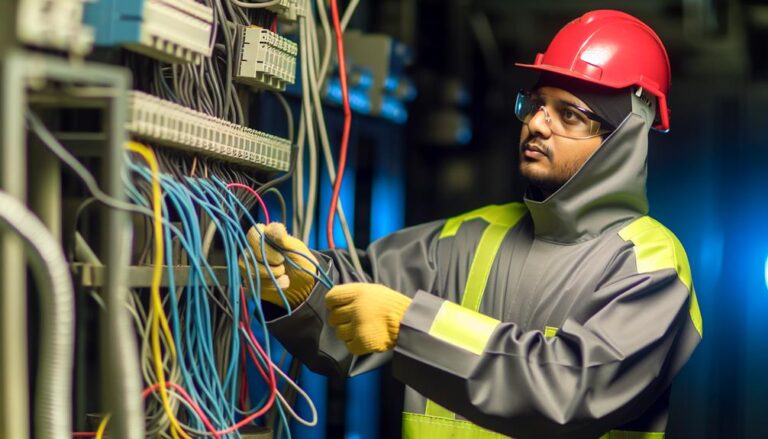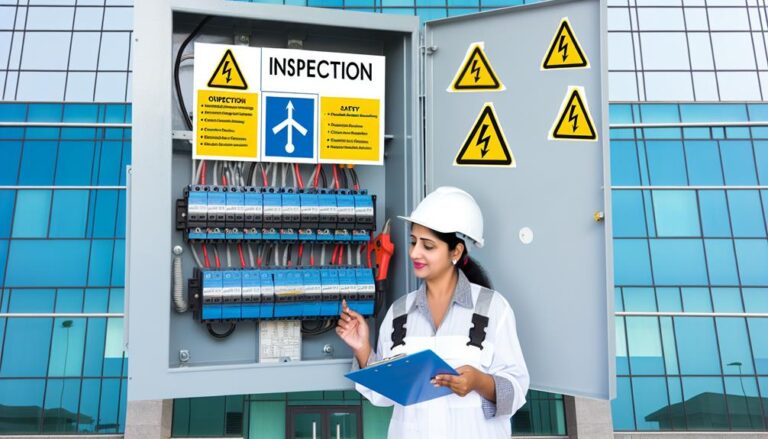The Role of Electricians in Smart Commercial Building Design
Did you know that smart commercial buildings are projected to reach a market value of over $57 billion by 2024? As an electrician, you play a crucial role in the design and implementation of these intelligent spaces.
From installing the necessary electrical infrastructure to integrating smart systems and ensuring energy efficiency, your expertise is essential in creating buildings that are not only technologically advanced but also sustainable.
But what exactly does your role entail? How do you collaborate with other professionals to bring these innovative designs to life?
In this discussion, we will explore the multifaceted role of electricians in smart commercial building design, highlighting the various responsibilities and contributions that make your expertise indispensable.
Key Takeaways
- Electricians play a crucial role in the installation and maintenance of electrical infrastructure in smart commercial buildings.
- They are responsible for analyzing the building’s electrical requirements and developing comprehensive plans to meet power needs while complying with codes and regulations.
- Electricians also contribute to the integration of smart systems, collaborating with IT specialists and automation engineers to install and configure infrastructure for communication and program and configure smart systems.
- Ensuring energy efficiency is another important aspect of an electrician’s role, involving the design and installation of energy-efficient electrical systems, conducting energy audits, and integrating renewable energy sources into the electrical grid.
Electrical Infrastructure Installation
When installing electrical infrastructure in smart commercial buildings, it’s crucial to ensure precise and efficient implementation for seamless operation. As an electrician, your role in the design and installation process is essential to guarantee the functionality and performance of the building’s electrical systems.
To begin with, you must carefully analyze the building’s electrical requirements and develop a comprehensive plan. This includes determining the power needs of various devices and systems, such as lighting, HVAC, security, and communication systems. By understanding these requirements, you can design a system that optimizes energy usage and promotes sustainability.
Next, you’ll need to install the necessary electrical components and wiring. This involves working with different types of cables, conduits, and connectors to ensure proper connectivity and safety. Additionally, you must comply with all relevant electrical codes and regulations to maintain a secure and reliable electrical system.
During the installation process, it’s crucial to pay attention to detail and maintain a high level of accuracy. Any errors or oversights in the installation can lead to operational issues, safety hazards, or even system failures. By carefully following the design plan and employing industry best practices, you can ensure the successful implementation of the electrical infrastructure.
Integration of Smart Systems
To ensure seamless operation and optimal performance of the electrical systems in smart commercial buildings, electricians play a crucial role in integrating smart systems. The integration of smart systems involves connecting various components and devices in a building to create a unified network that can be controlled and monitored centrally. Electricians are responsible for installing and configuring the necessary infrastructure, such as sensors, actuators, and controllers, to enable communication between different systems.
One key aspect of integrating smart systems is the implementation of a building management system (BMS). The BMS acts as the central control hub, allowing building operators to monitor and control various aspects of the building, such as lighting, HVAC systems, and security. Electricians work closely with other professionals, such as IT specialists and automation engineers, to ensure that the BMS is properly integrated with the electrical systems.
Another important aspect of integration is the integration of renewable energy sources, such as solar panels or wind turbines, with the electrical grid. Electricians are responsible for connecting these energy sources to the building’s electrical system and ensuring that they operate efficiently and safely.
In addition to the physical integration of smart systems, electricians also play a role in programming and configuring the systems. They work with software engineers and system integrators to ensure that the systems are properly configured and that they function in accordance with the building’s requirements.
Maintenance and Troubleshooting
For effective operation and prompt resolution of issues, electricians employ their technical expertise in maintaining and troubleshooting smart systems in commercial buildings. With their skills and knowledge, electricians play a crucial role in ensuring the smooth functioning of these systems, which are integral to the efficient operation of smart buildings.
Here are three key aspects of maintenance and troubleshooting that electricians focus on:
- Regular inspections and preventive maintenance: Electricians conduct routine inspections to identify any potential issues or malfunctions in the smart systems. By performing preventive maintenance tasks such as cleaning, lubricating, and testing the systems, they can prevent major problems from arising and ensure the longevity of the equipment.
- Diagnosing and resolving technical issues: When a problem occurs, electricians use their technical expertise to diagnose the issue and determine the appropriate solution. They rely on their understanding of the smart systems’ components and the underlying technology to troubleshoot and fix any malfunctions promptly.
- Updating and upgrading systems: Electricians stay updated with the latest advancements in smart technology to ensure that the commercial building’s systems are up to date. They can recommend and implement upgrades or modifications to improve the performance and efficiency of the smart systems.
Ensuring Energy Efficiency
How can electricians ensure optimal energy efficiency in smart commercial buildings?
To achieve this, electricians must carefully design and install energy-efficient electrical systems that integrate seamlessly with the building’s smart infrastructure. This involves conducting a thorough energy audit to identify areas of improvement and implementing energy-saving measures.
One key aspect of ensuring energy efficiency is the installation of advanced lighting systems. Electricians can install smart lighting controls, such as occupancy sensors and daylight harvesting systems, which automatically adjust lighting levels based on occupancy and natural light availability. Additionally, using energy-efficient LED lighting fixtures can significantly reduce energy consumption and maintenance costs.
Another crucial factor is the proper installation of HVAC systems. Electricians can work closely with HVAC technicians to ensure that the electrical components of these systems, such as motors and controls, are properly sized and calibrated for optimal energy efficiency. They can also install smart thermostats and zone controls, allowing for precise temperature regulation in different areas of the building.
Furthermore, electricians can integrate renewable energy sources, such as solar panels or wind turbines, into the building’s electrical system. By doing so, they can reduce the reliance on traditional energy sources and lower overall energy consumption.
Collaboration With Other Professionals
Collaborating with other professionals is essential for electricians to ensure seamless integration of energy-efficient electrical systems into the building’s smart infrastructure. By working closely with architects, engineers, and automation specialists, electricians can contribute their expertise and ensure that the electrical systems are designed and installed in a way that optimizes energy consumption and enhances the building’s overall efficiency.
Here are three key areas where collaboration with other professionals is crucial:
- Architects: Electricians need to collaborate with architects to understand the building’s layout and design. This collaboration helps in determining the placement of electrical outlets, lighting fixtures, and other electrical components in a way that maximizes energy efficiency and minimizes the need for extensive rewiring or modifications in the future.
- Engineers: Collaboration with engineers is important to ensure that the electrical systems are designed to meet the building’s energy needs while adhering to safety standards and regulations. Engineers provide valuable insights into load calculations, system capacity, and electrical distribution, allowing electricians to design and install systems that are both efficient and reliable.
- Automation specialists: Electricians must collaborate with automation specialists to integrate the electrical systems with the building’s automation and control systems. This collaboration ensures that the electrical systems can be monitored, controlled, and optimized for energy efficiency through a centralized management system.







